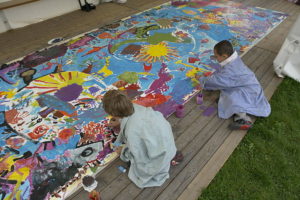I read a fascinating story about bees this week. I like bees, because I like the fruits I eat. I like bees a lot that I even wrote a book about the bees.
 http://www.meegenius.com/store/search?q=rani%20iyer
http://www.meegenius.com/store/search?q=rani%20iyer
Today’s post extends beyond the book. Until I worked in the tropical forests, I did not know about the diversity of bees in the world. All I knew was the honey bee and I assumed that all bees lived in nice social set up. It was a pleasant shock to learn about the 20,000 known bee species. According to world bee diversity almanac, the United States has more than 3500 species of bees!
Living in a temperate country, I also learned about ground nesting bees. During winter, the bees dig a hole and bury themselves deep in the ground. They usually emerge in spring.
I have found several spots in my garden that are favorite for the ground nesting bees. I am thankful for the cherries, apples, and all the fruits and vegetables I get to eat every day. None of these would be possible without bees. But, bees are not here forever as we might assume.
Marla Spivak explains the danger faced by the bees:
Scientists are always on the lookout for expanding our knowledge about bees. Recently, Hillary Erenler, a pollination biologist who loves butterflies, got distracted by a bee. The bee that caught her attention lived in an astonishing place and leading a dangerous life.
Located just outside of Nicaraguan capital city, Mangusa, is Mayasa, an active volcano. This volcano spews out noxious fumes and releases slow-cooling lava. Not many plants have survived this combination. Without plants, there are few animals too. The barren cliffs are an indication of the toxic air. See the map and pictures of the location.
Under the constant acid rain and high temperatures, Hillary saw some bees. Bees? What were the bees doing in this place?
The bees, Anthophora squammulosa, actually built its nest by burrowing into a pile of volcanic debris.
Scientists estimate about 2,000 bees are living in the location. Majority of the bees are solitary. Researchers had observed the bees feeding on several flowers. They thought the bees were generalists. However, when the honey was analyzed, the researchers were in for a surprise. The bees almost exclusively pollinated a Melanthera flowers. Like the bee, the plant too is tough and can survive the acid rain and high temperatures.

Melittologists, scientists who study bees, are impressed. Not only for the intricate relationship between the bee and plant, but also for the ability of this tiny bee to live so close a large, active volcano. Here, the air is high in Sulphur dioxide and the temperature is close to 42 degrees. Now that scientists know about the bees, they need to be more creative in coming up with ways to protect them. A volcano so active and so large could have a large episode of eruption.
It is a fascinating to study about the manner in which life expands with every opportunity. We too could adopt that trait in our life.


Thanks for pointing me to your blog Rani. Fascinating stuff.
Thank you!